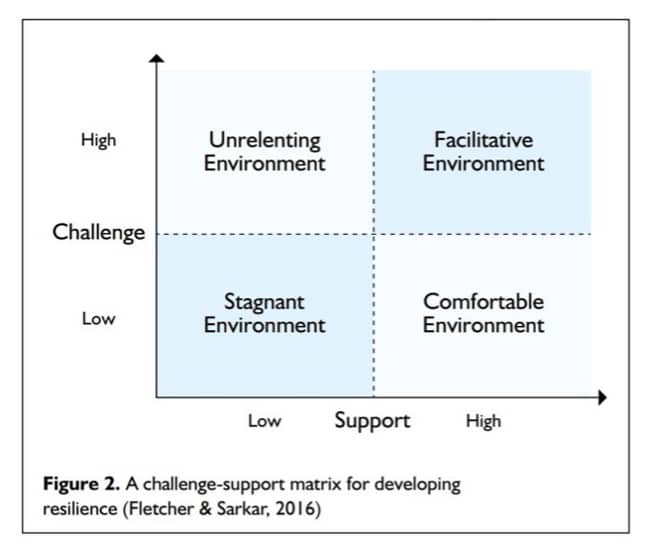Building Resilience in Your Team

In the realm of business, leaders are constantly looking for new ways to expand their team and organization’s performance. If the last few years have taught leaders and team members anything, it’s that sustaining high performance in a world that is changing faster than ever can be a real challenge.
Enter resiliency. Resiliency can be defined as “the ability to use personal qualities to withstand pressure” (Fletcher and Sarkar, 2016). We often refer to these personal qualities as protective qualities or adaptive coping skills. These are skills that allow us to effectively manage a situation, whether it be adverse or favorable.
So how do we cultivate ourselves and our teams to be resilient?
Current research and best practices in the field of performance psychology lean heavily on leaders helping to create a facilitative environment. Simply, understanding and balancing the relationship between expectations and support.

Stagnant Environment: Low challenge/Low support. Not much is happening in this environment. Leaders often feel out of tune with their teams and team members feel a lack of stimulation and boredom.
Unrelenting Environment: High challenge/Low support. Individuals can feel isolated, lonely. Little emphasis on well-being. Blame culture.
Comfortable Environment: Low challenge/High support. Things may be going reasonably well in this environment for periods of time. Leaders and team members become complacent. Begin to get comfortable engaging in tasks they find easy.
Facilitative Environment: High challenge/High support. Individuals feel safe to make mistakes and take risk. Team members are looking to challenge themselves and seek out feedback. Leaders and team members feel purposeful in their work and are working towards a greater impact within their organization and marketplace.
Action List for Facilitative Environment:
- Individual conversations with your team members. Learn what motivates each team member and identify growth areas. Invite them to share their future goals and help them build a path towards development within the organization.
- Conversations with your entire team. Bring your team together to discuss what you want to accomplish together and the impact your team wants to have on the organization. Teams that understand how they contribute to the broader organizational strategy are more engaged, committed, and resilient. Begin to identify who owns what initiatives, reinforce their value, and discuss how to hold each other accountable in a productive way.
- Ongoing calibration. Be in regular communication with your team about individual and team goals, growth areas, and strengths. Celebrate successes as well as discuss challenges. Help the team feel safe and supported even when mistakes happen. Help team members collaborate with each other in solving tough problems and acquiring new skills. Adjust goals and duties as time goes on.
Creating a facilitative environment and getting your team on board is no easy challenge. It requires more time from you as a leader as well as more time for vulnerable conversations. But, when leaders commit to keeping themselves and their team in an environment that not only challenges but supports them, organizations begin to see the individual and team performance that cultivates the illusive high-performance culture.
